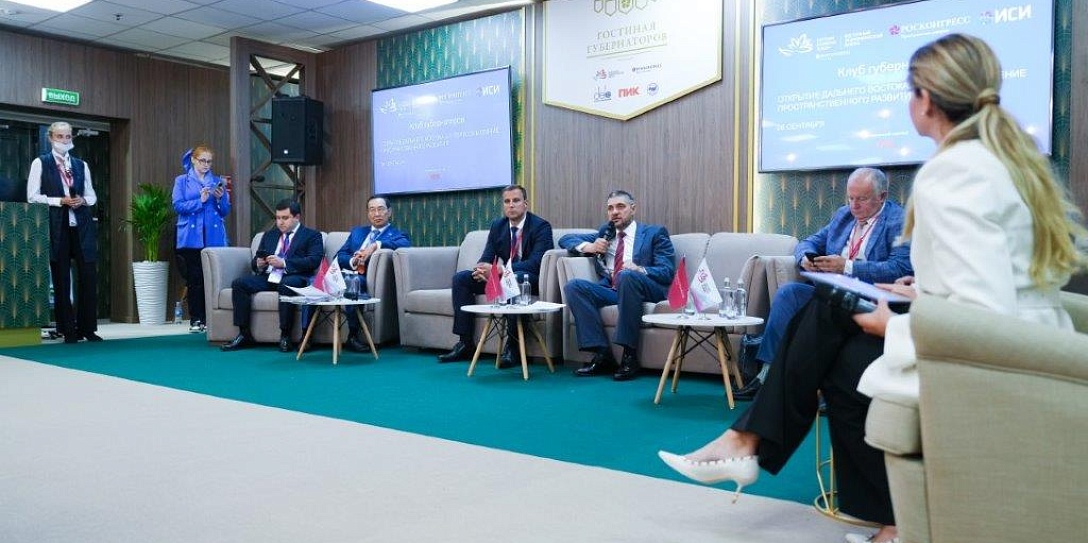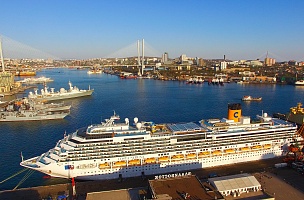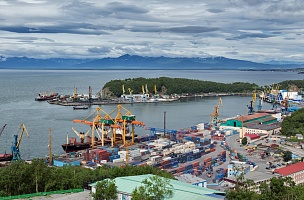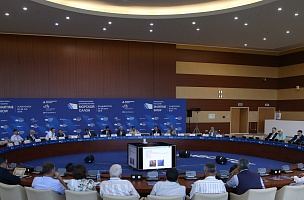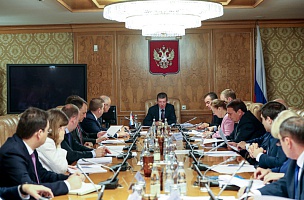On 6 September, the Eastern
Economic Forum (EEF 2022) hosted a panel discussion by the Governors’ Club
entitled ‘Opening the Far East 2.0: Reimagining Spatial Development’. The event
was organized by the Roscongress Foundation and the Expert Institute for Social
Research (EISR). The PIK Group was the general partner of the event. Heads of
Russian regions and representatives of federal agencies discussed social aspects
of territorial development in the Far East and assessed the impact of housing
construction on the quality of life.
The panellists were Nikita
Stasishin, Deputy Minister of Construction, Housing and Utilities of the
Russian Federation; Grigory Kuranov, Deputy Plenipotentiary Envoy of the
Russian President in the Far Eastern Federal District; Ivan Polandov, First
Deputy General Director of PIK – Specialized Developer; as well as the new wave
governors: Aisen Nikolayev, Head of the Republic of Sakha (Yakutia); Alexander
Osipov, Head of Transbaikal Territory; Alexey Tsydenov, Head of the Republic of
Buryatia; and Rostislav Goldstein, Governor of the Jewish Autonomous Region.
The panel discussion was
moderated by Daria Kislitsyna, Director of EISR’s Regional Programme
Department. “Our country is implementing a spatial development strategy. Just like
any practical tool, it is constantly being updated, including the rethinking of
the role of the Far Eastern regions and their geopolitical significance. A transformation
in the understanding of their importance is possible, and its cornerstone is
social reality, i.e. how people feel and whether they want to live in these
territories. In the discussion, we want to look at how social infrastructure
and building infrastructure are combined in the prism of the regions, how it
all affects people and is perceived by them,” the moderator set the vector for
the discussion.
Aysen Nikolayev said that
Yakutia had all the potential to increase the rate of housing construction and
to create social and engineering infrastructure in residential quarters. The
Head of the Republic said that the region had managed to significantly increase
the rate of housing construction and was among Russian leaders in terms of
construction growth. He also said that Yakutia was constantly working to create
a comfortable urban environment, and that buildings were being transformed into
modern socially oriented spaces. The Head of Yakutia paid particular attention
to the need of developing infrastructure in the Far East as a priority. “How
can we compete with the regions where many problems were solved a long time ago
using a single methodology? We cannot. We need to have updated coefficients for
the Far East, so that we can develop. The Far East today needs to develop
faster than anyone else in order for the country as a whole to live better.
Today, we are in a situation where this has become a reality. The West has shut
down for a long time, for the rest of our lives for sure. Without the
development of the Far East, there will be nothing to talk about. Once and for
all, this turnaround must be formed, first and foremost a turnaround in
thinking,”
Nikita Stasishin spoke about
federal measures to support infrastructure development in the Far East. Such
measures include the Stimulus programme, which finances the construction of
engineering and transport infrastructure, as well as the Infrastructure Menu
project. The latter one makes it possible to finance social infrastructure
ahead of time. “There is a paradox in terms of housing construction in the Far
East. The cost of square metre is high. On top of construction cost and sales
price, there is the cost of investment. The latter one is precisely the thing
that drives new-quality housing projects. Developers compete in project quality
instead of price of square metre. Cost optimization is the task facing
governors and federal developers entering the Far Eastern construction market,”
stated Deputy Minister of Construction, Housing and Utilities of the Russian
Federation. He emphasized that there were a lot of interest to housing
construction in FEFD, which can result in implementing new-quality housing
projects as early as next year. “We will help, as we have been doing it. We
have been paying attention to the development of the Far East over the past
years,” summed up Mr. Stasishin.
Ivan Polandov agreed that
government programmes have increased the interest of developers and businesses
in Far East projects. “Price growth is a two-way street. It can be
counterbalanced by an increase in supply. On the other hand, the price allows
regulating the quality of the product. With the arrival of Moscow’s players and
major developers, there is a unique opportunity to bring the experience of
high-quality master planning, creating public spaces, which is successfully
implemented in the metropolitan region, and spread it to the Far East,”
believes the First Deputy CEO of PIK – Specialized Developer. He stressed that
over the next few years, the quality of products in the Far Eastern regions
will change for the better, and people will receive high-quality and
comfortable housing.
Grigory Kuranov drew the
discussion participants’ attention to the fact that the state should provide
people with an opportunity to live comfortably, but it is important to
understand who the recipients of comfortable housing are. The Deputy
Plenipotentiary Envoy of the RF President in the Far Eastern Federal District is
convinced that one of the key recipients of comfortable housing is young
people. That is why, in the speaker’s opinion, it is necessary to determine
what the state wants this social group to be. “We can build as many houses as
we want and make the cost per square metre whatever we want. But housing
construction is a task, while the goal is to maintain a successful and
sovereign state. While carrying out the task, one should not forget the goal.
It is important to think about how we educate those who will live in these
houses,” concluded Mr. Kuranov.
New wave governors
representing Far Eastern regions shared their experience in developing the
housing construction system, spoke about existing government support measures
in this area, and highlighted pressing issues in the industry.
As Alexey Tsydenov noted, the
implementation of systemic measures as part of the Housing and Urban
Environment national project and situational state support for the construction
industry in the face of sanctions made it possible to prevent a standstill in
housing construction in the Republic of Buryatia. At the same time, Tsydenov
regards the lack of vacant land plots with engineering infrastructure as the
main problem for the development of housing construction in the Republic. He
also stressed that Buryatia has significantly improved the state of the urban
development since 2017 thanks to the successful implementation of the project ‘Forming
a Comfortable Urban Environment’. The Head of the Republic emphasized that government
support for infrastructure development in the Far East should be balanced, and
housing construction should be integrated. “Comprehensive development that lays
the foundation for a vibrant city includes the environment, transport,
aesthetics, and other parameters. It should make people’s lives rich and fulfilling.
People in the Far East should not have a sense of a ‘postponed life’ or a
feeling that they need to save money and run away somewhere. It is important to
give people a perspective and an understanding that this is where one can and
should live, fulfil, and develop. This can be achieved through a master plan
tool. It is the task of the master plan to create a city where you want to live
yourself and your children want to live and build their future. Then people
will come to the Far East, and the locals will not want to leave,” explained
Mr. Tsydenov.
Alexander Osipov shared the
experience of housing construction in Transbaikal Territory. He explained that,
due to the region’s new urban planning policy, the construction of residential
quarters as part of integrated development started in 2020. The main area of
spatial development is the construction of modern residential quarters with the
organization of public spaces, designed to create a comfortable environment for
the residents of the region. Osipov said that five sites that had found federal
support were being launched in Transbaikal Territory with an integrated
approach to housing construction. According to the Governor, this was made
possible thanks to the Infrastructure Menu federal project and modern
mechanisms for the development of the Far East (Far Eastern Quarter, and
others). Mr. Osipov drew the discussion participants’ attention to the
importance of implementing an integrated approach to housing construction, with
all agencies working in sync to solve a common problem. “On the one hand, there
is a number of programmes. We will be building 9 new schools – something that
has not happened in a long time – and 18 kindergartens. But the principle these
facilities are being built under is determined by the federal agencies
according to their parameters and targets. But that is not the principle of
integrated development. It would be good if, in the next phase, the region
would synchronize its support measures with the federal authorities,” shared
the Governor.
Rostislav Goldstein drew
attention to the need to rethink the approach to spatial development in Far
Eastern regions. “All of the programmes that the government is currently
developing are designed to develop housing construction, and they are doing so
successfully. However, there are regions, such as the EAD, that do not qualify
for the programmes due to their averageness. But the Far East is not an average
territory. If we are talking today about the rapid development of the Far East,
then living conditions in the Far East should be comparable to those in the
capital, Moscow and St. Petersburg,” stressed the Governor. He also said that
when implementing infrastructure projects, the question of how to motivate
people to stay in the Far Eastern regions cannot be ignored. “The attention
that we have to the Far East today needs to be multiplied by a hundred,”
concluded Mr. Goldstein.
The discussion showed that the
key to the successful spatial development of the Far East in the new circumstances
is a comprehensive approach that takes into account the social aspect and aims
to ensure comfortable living conditions for people in the Far Eastern regions.


